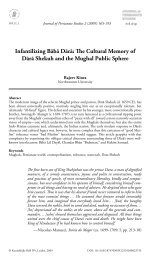The Mughals, the Sufi Shaikhs and the Formation of the Akbari ...
The Mughals, the Sufi Shaikhs and the Formation of the Akbari ...
The Mughals, the Sufi Shaikhs and the Formation of the Akbari ...
Create successful ePaper yourself
Turn your PDF publications into a flip-book with our unique Google optimized e-Paper software.
FORMATION OF THE AKBARI DISPENSATION 149<br />
became <strong>the</strong> shaikh al-Islam <strong>of</strong> <strong>the</strong> city <strong>of</strong> Samarq<strong>and</strong>, combining with<br />
it <strong>the</strong> trusteeship <strong>of</strong> rich endowments settled on <strong>the</strong> tomb <strong>of</strong> Khwaja<br />
Ahrar. 40<br />
It is well known that between 1500 <strong>and</strong> his conquest <strong>of</strong> India, Babur<br />
came into contact with Shah Isma’il Safavi <strong>and</strong> with his help avenged<br />
himself upon <strong>the</strong> Uzbeks for <strong>the</strong> devastation <strong>the</strong>y had wreaked on <strong>the</strong><br />
Timurids <strong>and</strong> <strong>the</strong>ir associates in Central Asia. Because <strong>of</strong> his close<br />
relations with <strong>the</strong> Safavid Shah, who was not an orthodox Shi’a but<br />
a zealous propagator <strong>of</strong> heterodox Shi’ism, Babur is also alleged to<br />
have temporarily developed Shi’a leanings. It is also reported that<br />
a Naqshb<strong>and</strong>i shaikh <strong>of</strong> <strong>the</strong> time, Ahmad ibn Jalal al-Din Khwajagi<br />
admonished him for his seeking help from <strong>the</strong> Shah <strong>of</strong> Iran <strong>and</strong> asked<br />
him instead to accept Shaibani Khan as a khalifa. 41 Bethatasitmay,<br />
Babur never<strong>the</strong>less remained a lifelong devotee <strong>of</strong> Khwaja Ahrar. Of<br />
interest here is an anecdote pertaining to Babur’s victory over Ibrahim<br />
Lodi in <strong>the</strong> battle <strong>of</strong> Panipat in 1526. <strong>The</strong> anecdote is reported by a<br />
seventeenth-century historian, Muhammad Sadiq. Sadiq writes that as<br />
Babur’s army was too small in opposition to a huge <strong>and</strong> near-countless<br />
Afghan brigade, he felt overwhelmed <strong>and</strong> feared that he might lose<br />
<strong>the</strong> battle to <strong>the</strong> enemy. He <strong>the</strong>n contemplated <strong>the</strong> image <strong>of</strong> Khwaja<br />
Ahrar as he had heard it described. All at once <strong>the</strong>re appeared a<br />
horseman dressed in white, fighting against <strong>the</strong> Afghans, who were<br />
<strong>the</strong>reupon completely routed. Later, after <strong>the</strong> fight, he narrated <strong>the</strong><br />
incident to one <strong>of</strong> his nobles. <strong>The</strong> noble told Babur that according to<br />
his description, <strong>the</strong> horseman in white was Maulana Ahmad Khwajagi.<br />
<strong>The</strong> same day, Babur sent one <strong>of</strong> his close courtiers to Khwajagi with<br />
several gifts toge<strong>the</strong>r with a portrait drawn on a piece <strong>of</strong> paper. Babur,<br />
40 Algar, ‘A brief history <strong>of</strong> <strong>the</strong> Naqshb<strong>and</strong>i order’, in Gaborieau, Popovic <strong>and</strong><br />
Zarcone (eds.), Naqshb<strong>and</strong>is, pp. 15–6.<br />
41 See Fazl-Allah ibn Ruzbihani Isfahani, Suluk al-Muluk, British Library, London<br />
Ms. Or. 253,Preface,fol.3a. Isfahani writes that with Babur’s help, heresy, which is to<br />
say Shi’ism, spread in Mawarannahr <strong>and</strong> that he, like <strong>the</strong> Iranian Shi’i leaders played<br />
a detestable role in bringing <strong>the</strong> mosques <strong>and</strong> o<strong>the</strong>r religious centres <strong>of</strong> <strong>the</strong> region<br />
beyond <strong>the</strong> river Jihun under <strong>the</strong> control <strong>of</strong> <strong>the</strong> heretic Shi’as. <strong>The</strong> region was thus afire<br />
with <strong>the</strong>ir mischief (fitna). All this happened because he invited <strong>the</strong> red-capped Safavid<br />
qizilbash to come to his help in his fight against <strong>the</strong> Uzbeks to recover Samarq<strong>and</strong> <strong>and</strong><br />
Bukhara. But for Ubaid-Allah Khan’s gallant struggle (jihad), <strong>the</strong> rites <strong>and</strong> symbols <strong>of</strong><br />
<strong>the</strong> true faith would have been completely routed in <strong>the</strong> region. See also <strong>the</strong> printed<br />
edition <strong>of</strong> this text by Muhammad ‘Ali Muvahhid (Tehran: Intisharat-i Khwarzimi,<br />
1362 Shamsi/1983), p. 50. For an English translation <strong>of</strong> this work, see Muhammad<br />
Aslam, Muslim Conduct <strong>of</strong> State (Islamabad: University <strong>of</strong> Islamabad Press, 1974),<br />
pp. 31–3.<br />
http://journals.cambridge.org Downloaded: 15 Feb 2011 IP address: 129.174.97.34






